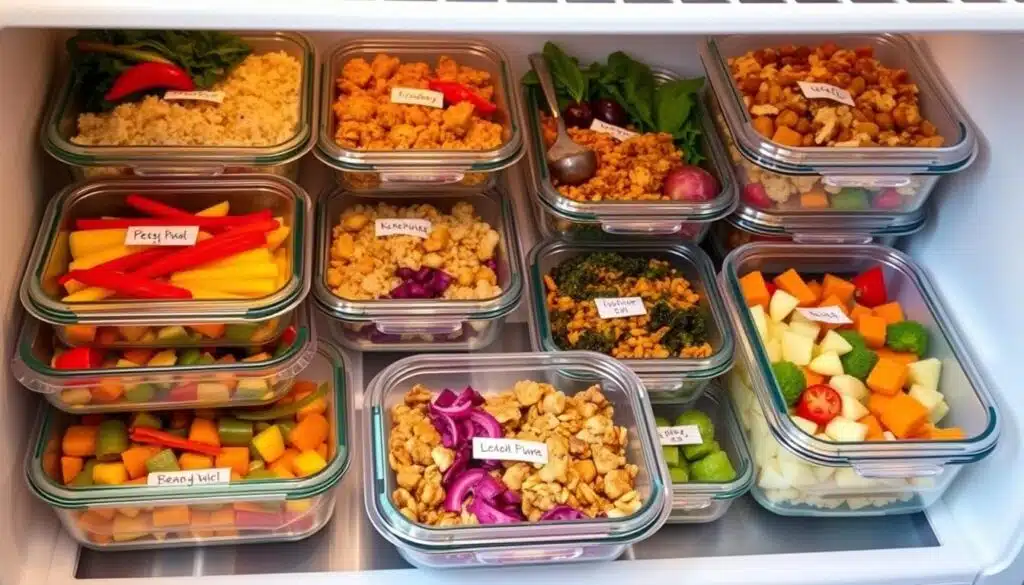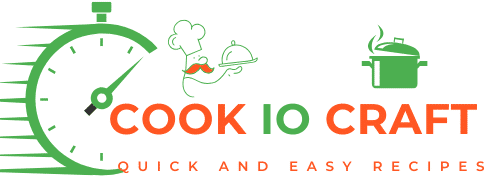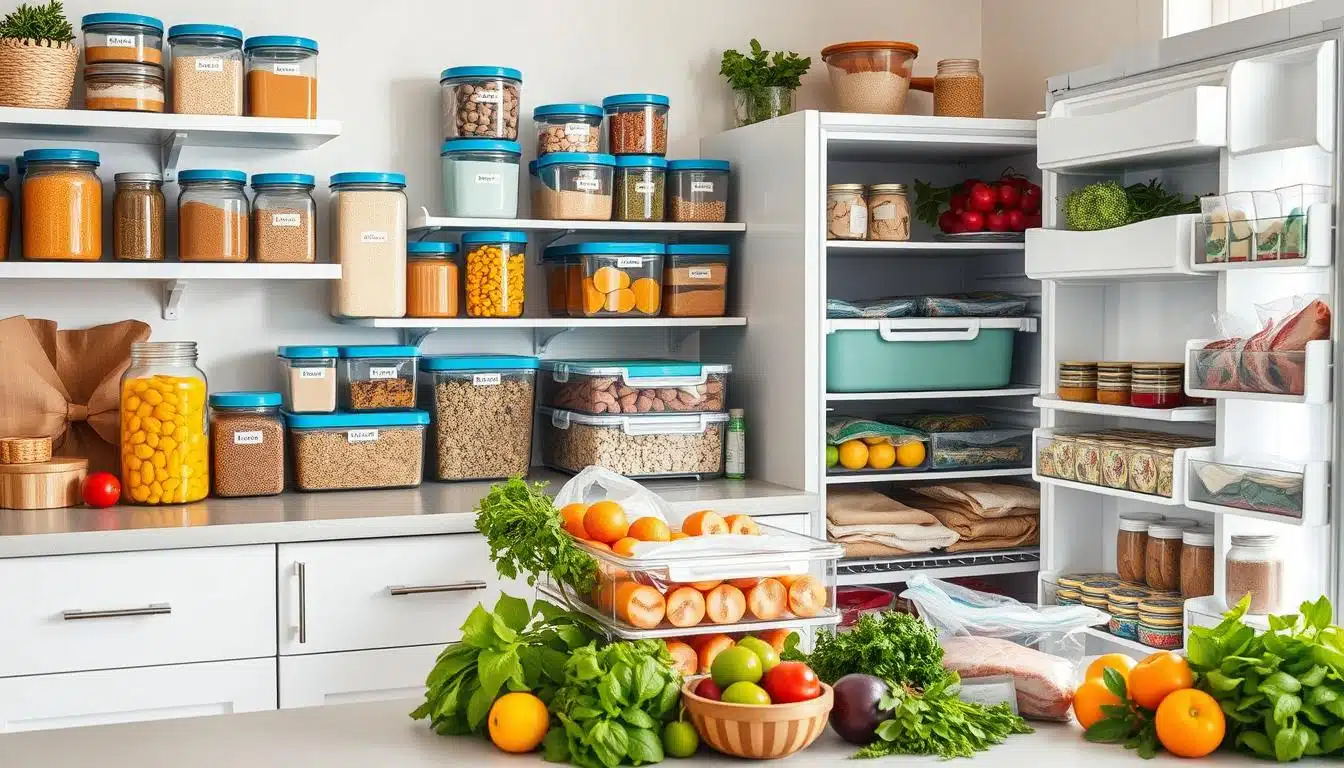We know you’re busy, and cooking can be a challenge. That’s why we’re here to help you with smart food storage tips and kitchen hacks. These can make your life easier. The Natural Resources Defense Council says 40% of food in the U.S. today goes uneaten. By using smart food storage tips, you can help save resources, money, and enjoy fresh meals while reducing waste.
Imagine having a fridge that’s organized, and you can find what you need in no time. With our food storage tips and kitchen hacks, you can reduce food waste and keep your kitchen running smoothly. We’ll explore strategies for storing fresh produce, dairy products, meat, and leftovers. We’ll also talk about the importance of meal planning and composting.
Key Takeaways
- Reducing food waste can help conserve resources and save money
- Smart food storage tips can help you enjoy fresh and delicious meals
- Kitchen hacks can make cooking easier and more efficient
- Proper meal planning can help reduce food waste
- Utilizing apps like FoodKeeper can assist in managing food inventory
- Freezing excess food items can prevent them from going bad and reduce waste
- Repurposing food scraps can help minimize waste
Understanding Food Waste and Its Impact
Reducing food waste is key to saving our environment and money. In the U.S., food waste often fills half of our trash bins. This waste is not just food; it’s also the energy, water, and land used to grow and transport it.
Producing, moving, and throwing away food waste uses a lot of energy, water, and land. This leads to greenhouse gas emissions and high waste management costs. For example, food waste is responsible for 4% of U.S. greenhouse gas emissions. Methane from rotting food in landfills is 84 times more harmful than carbon dioxide over 20 years.
The Environmental Consequences
Food waste has a big impact on our planet. It’s estimated to cause about 6.5% of global greenhouse gas emissions. The food supply chain is responsible for 26% of these emissions, with a quarter coming from waste.
The Economic Costs
Food waste also costs us a lot of money. Globally, it’s estimated to be $2.6 trillion annually. In the U.S., $408 billion worth of food is wasted each year. This could feed millions of people who don’t have enough to eat.
How Storage Solutions Can Help
Using smart storage can help reduce food waste and lower our environmental impact. Simple steps like using airtight containers and labeling food can help a lot. Donating extra food or composting waste also helps reduce costs and harm to the environment.
Best Practices for Storing Fresh Produce
Storing fresh produce right can make it last longer. Using produce drawers and keeping humidity levels right helps. It’s also key to know how ethylene gas affects it, as it can make things ripen and spoil quicker.
Choosing the right temperature settings is crucial too. Different fruits and veggies need specific temperatures to stay fresh. By picking the right containers and storing them at the right temperature, you can keep your produce fresh longer.
Utilizing Ethylene Gas Knowledge
Some fruits, like apples and bananas, produce more ethylene gas than others. Keeping these fruits apart from other produce can stop them from ripening too fast.
Optimal Temperature Settings
The best temperature settings for storing produce vary. Root veggies like potatoes and carrots do well in a cool, dark spot with high humidity. Leafy greens like kale and spinach need the fridge to stay fresh.
Container Choices
Picking the right containers for storing produce is key. Airtight containers or plastic bags help keep humidity in and keep things fresh. By following these tips, you can enjoy your produce longer and cut down on waste.
Maximizing Shelf Life of Dairy Products
Understanding dairy products expiration dates and storage conditions is crucial. It helps reduce waste and enjoy these items longer. Storing milk and other perishables on the fridge’s inner shelves keeps them fresh.
To extend the life of dairy products, follow some easy tips. Here are a few:
- Regularly check expiration dates to use the oldest items first.
- Use airtight containers to keep dairy products fresh.
- Ensure your fridge stays at a consistent temperature to avoid spoilage.
By following these tips and paying attention to storage conditions, you can enjoy your dairy products for longer. Proper storage is essential for keeping them fresh and safe to eat.

Effective Meat and Poultry Storage Techniques
Storing meat and poultry right is key to keeping them fresh and safe. Freezing and refrigerating are top methods to extend their life. Learning about food storage can show you the perks of these methods.
Freezing meat and poultry stops spoilage and cuts down on waste. Vacuum sealing also fights freezer burn, making food stay fresh longer. Important tips for good storage include:
- Keep meat and poultry at 0°F (-18°C) or below to stop bacteria growth
- Use vacuum sealing to remove air and avoid freezer burn
- Label and date stored items to use them safely within time
By sticking to these tips and using the right storage, you can enjoy meat and poultry longer. Always check stored food for spoilage before eating.
Organizing Your Pantry for Long-Term Use
Organizing your pantry is all about creating a system that works for you. Categorize food items, use the first-in, first-out method, and label essentials. This way, your pantry will be functional and easy to navigate.
A well-organized pantry can help reduce food waste. It ensures older items are used before they expire. By using the first-in, first-out method, you can avoid expired food. With a bit of planning and creativity, your pantry can be both beautiful and functional.
For pantry organization, use clear containers and a uniform basket type. This minimizes chaos and enhances organization. Adding personal touches like wallpaper or custom doors can make your pantry more appealing. By following these tips and using good food storage and labeling techniques, you can make your pantry both functional and beautiful.
Also, consider using floor baskets for snacks and bulk items. Large floor baskets are great for storing items not needed right away. With creativity and planning, you can make your pantry organized and functional. This makes it easier to find what you need and reduces food waste.
Smart Solutions for Leftover Meals
Reducing food waste is easy with creative leftover meals. Knowing how to cool and reheat leftovers makes a big difference. At CookioCraft, we aim to make cooking simple and fun. That’s why we offer resources like our terms of service to guide you.
It’s important to cool and reheat leftovers right to avoid illness and waste. For instance, using shallow containers and refrigerating quickly stops bacteria. Here are some tips for leftover meals:
Proper Cooling Methods
- Use shallow containers to cool leftovers quickly
- Refrigerate leftovers promptly to prevent bacterial growth
- Label and date leftovers so you know how long they’ve been stored
Reheating Guidelines
- Reheat leftovers to an internal temperature of 165°F (74°C)
- Use a food thermometer to ensure leftovers are heated evenly
- Avoid reheating leftovers multiple times, as this can increase the risk of foodborne illness

By following these tips, you can enjoy leftovers while cutting down on waste. Always prioritize food safety when reheating. Get creative with your leftovers to make new dishes. With practice, you’ll be a pro at reducing waste and making the most of leftovers.
| Leftover Meal | Cooling Method | Reheating Guideline |
|---|---|---|
| Turkey | Shallow container, refrigerate promptly | Reheat to 165°F (74°C) |
| Vegetables | Shallow container, refrigerate promptly | Reheat to 165°F (74°C) |
| Pasta | Shallow container, refrigerate promptly | Reheat to 165°F (74°C) |
Understanding the Importance of Designated Zones
Designating specific zones for different types of food is key to reducing waste and keeping your kitchen organized. By setting up designated zones, you can store items in the best place. This reduces spoilage and waste. For example, a “use first” bin helps avoid expired food in the pantry.
It’s also smart to separate cold and dry storage areas. This keeps perishable items fresh. It’s all about creating the right environment for your food.
To make your kitchen more efficient, use storage areas that are easy to reach and see. Stackable containers, baskets, or bins are great for this. They help you find what you need quickly. Plus, they keep similar items together, reducing clutter and making cooking easier.
Designating zones has many benefits. It can help you:
- Reduce food waste
- Make meal prep more efficient
- Keep your kitchen organized and clutter-free
- Access ingredients and supplies easily
By using these simple tips, you can make your kitchen more functional and efficient. This reduces waste and makes cooking a breeze. Always check and adjust your designated zones to keep your kitchen organized and waste-free.
Utilizing Technology to Track Food Expiration
Using technology is key to cutting down on food waste. Smartphone apps help us track food expiration dates and manage our food. This way, we can keep our food fresh and safe, lowering the chance of getting sick from bad food.
Food inventory management systems help us monitor the food at home. They remind us when food is about to expire. This is great for people who are always busy and often throw away bad food.
Using tech to track food expiration has many benefits:
- Less food waste: We can plan meals and shop better, avoiding expired food.
- Better food safety: Proper handling and storage reduce the risk of getting sick from food.
- More efficiency: Apps and systems make meal planning and shopping easier, saving time.
By using tech like apps and inventory systems, we can greatly reduce food waste.
Composting: An Eco-Friendly Alternative
Composting is a great way to cut down on food waste. It turns organic stuff into soil that’s full of nutrients. This helps the environment and supports a circular economy, where we use resources wisely.
Composting is easy to do every day. You just need to collect food scraps and yard waste. Then, let them break down into soil that’s good for plants. It works in homes and community programs too.
The Basics of Composting
To start composting, you need to know the basics. You should know what can be composted, like food and yard waste. And what can’t, like plastics and metals. Following these rules helps make composting work well and last long.
Contributing to a Circular Economy
Composting is key to a circular economy. It helps us use resources better and waste less. By composting, we can make our environment better and help the planet for the future. It’s a green way to live, from less food waste to saving natural resources.
Establishing a Meal Planning Routine
Creating a consistent meal planning routine helps reduce food waste and saves money. By planning meals and making a detailed shopping list, you only buy what you need. This way, you avoid wasting food and money.
Benefits of Meal Prep
Meal prep has many benefits. It saves time during the week, keeps your diet balanced, and can save money. With a plan, you’re less likely to spend on takeout or impulse buys.
Creating a Comprehensive Grocery List
A detailed grocery list is key to a good meal plan. Check what you already have at home and plan meals around it. This way, you avoid buying the same things twice and use all your food.
Adjusting to Seasonal Ingredients
Using seasonal produce in your meals is smart. It’s often cheaper and tastes better when it’s in season. This way, you can try new recipes and keep your meals interesting.

